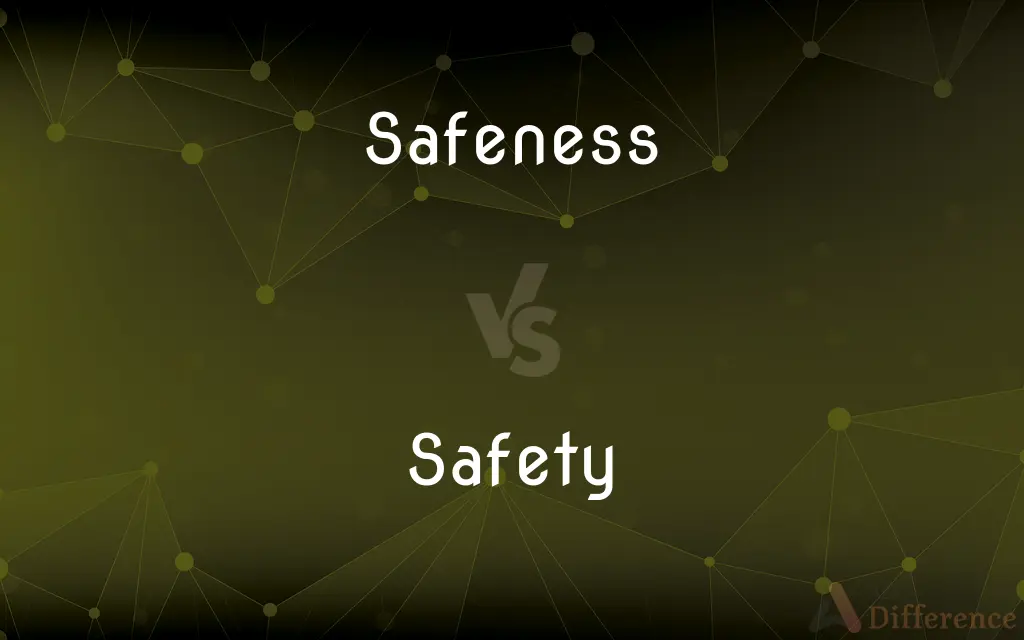Safeness vs. Safety — What's the Difference?
By Tayyaba Rehman — Updated on November 1, 2023
"Safeness" is the state of being safe; "safety" is the condition of being protected from harm or a set of measures to achieve this.

Difference Between Safeness and Safety
Table of Contents
ADVERTISEMENT
Key Differences
"Safeness" is a term that signifies the inherent state or condition of being safe or secure from danger or harm. It suggests a static state of absence of risk or threat. "Safety," on the other hand, is a broader term that encompasses the state of being safe, as well as the strategies, procedures, and measures put in place to prevent harm or danger.
When discussing "safeness," one might refer to the intrinsic quality of an object or environment that makes it unlikely to cause harm or danger. In contrast, "safety" is often used to refer to the active efforts and precautions taken to protect individuals from potential risks, such as safety equipment or safety protocols.
"Safeness" implies a passive condition, a situation where safety is inherent and does not need to be actively maintained. "Safety" is more proactive and dynamic, suggesting continuous actions and practices designed to maintain a safe state or environment.
The concept of "safeness" can be perceived as the result of safety measures. Once all safety precautions are in place, a state of "safeness" may be achieved. Meanwhile, "safety" is about the ongoing process and commitment to creating and upholding that state.
In everyday language, "safeness" is less commonly used than "safety." The latter is a more comprehensive term that includes both the concept of a safe state and the means to achieve and ensure it. "Safety" tends to be the preferred term in most legal, technical, and general contexts.
ADVERTISEMENT
Comparison Chart
Definition
State of being safe.
Condition or measures of being protected from harm.
Usage Frequency
Less commonly used.
More commonly used.
Context
Often describes inherent qualities.
Describes broader concepts including practices and conditions.
Nature
Generally static.
Dynamic and procedural.
Focus
On the absence of risk.
On the creation and maintenance of a safe environment.
Compare with Definitions
Safeness
A state where security is inherent.
The safeness of the neighborhood was well-known.
Safety
Practices implemented to prevent accidents or harm.
The company prioritizes safety training for all its employees.
Safeness
The condition of not being dangerous.
The safeness of the toy for small children was verified by experts.
Safety
A condition that is the result of being safe and secure.
Fire drills are essential for ensuring the safety of the students.
Safeness
The intrinsic quality of being unlikely to cause harm.
The safeness of the design prevented any accidental injuries.
Safety
Regulations and policies established to maintain a secure environment.
The new safety regulations will take effect next month.
Safeness
The perception of an environment where threats are absent.
Visitors felt the safeness of the park at daytime.
Safety
The state of being protected from or not exposed to danger.
Safety measures were enhanced following the recent incidents.
Safeness
Free from danger or injury; undamaged or unhurt
He returned from the voyage safe and sound.
Safety
Safety is the state of being "safe", the condition of being protected from harm or other danger. Safety can also refer to the control of recognized hazards in order to achieve an acceptable level of risk.
Safeness
Not exposed to the threat of danger or harm
The children were safe at home all through the storm.
Safety
The condition of being safe; freedom from danger, risk, or injury.
Safeness
Usable in specified conditions without being damaged. Often used in combination
A microwave safe container.
Safety
A device designed to prevent accidents, as a lock on a firearm preventing accidental firing.
Safeness
Free from risk; not liable to be lost; sure
A safe bet.
Safety
A play in which a member of the offensive team downs the ball or is tackled or forced out of bounds behind his own goal line, resulting in two points for the defensive team.
Safeness
Affording protection
A safe place.
Safety
Either of two defensive backs normally positioned behind the linebackers in the middle of the backfield.
Safeness
(Baseball) Having reached a base without being put out, as a batter or base runner.
Safety
The condition or feeling of being safe; security; certainty.
If you push it to the limit, safety is not guaranteed.
Safeness
A metal container usually having a lock, used for storing valuables.
Safety
(mechanics) A mechanism on a weapon or dangerous equipment designed to prevent accidental firing.
Be sure that the safety is set before proceeding.
Safeness
A repository for protecting stored items, especially a cooled compartment for perishable foods
A cheese safe.
Safety
(American football) An instance of a player being sacked or tackled in the end zone, or stepping out of the end zone and off the field, resulting in two points to the opposite team.
He sacked the quarterback in the end zone for a safety.
Safeness
The property of being safe.
The safeness of the new drug hadn't been proven, so it could only be used experimentally, and you had to sign a waiver accepting the risks.
Safety
(American football) Any of the defensive players who are in position furthest from the line of scrimmage and whose responsibility is to defend against passes as well as to be the tacklers of last resort.
The free safety made a game-saving tackle on the runner who had broken past the linebackers.
Safeness
The quality or state of being safe; freedom from hazard, danger, harm, or loss; safety; security; as the safeness of an experiment, of a journey, or of a possession.
Safety
(baseball) A safety squeeze.
Safeness
The quality of being safe
Safety
Preservation from escape; close custody.
Safeness
Being free from the occurrence of risk.
The safeness of the bridge after the repairs reassured the community.
Safety
(dated) A safety bicycle.
Safety
(transitive) To secure (a mechanical component, as in aviation) to keep it from becoming detached even under vibration.
Safety
To secure a firing pin, as in guns, to keep the gun from firing
Safety
The condition or state of being safe; freedom from danger or hazard; exemption from hurt, injury, or loss.
Up led by thee,Into the heaven I have presumed,An earthly guest . . . With like safety guided down,Return me to my native element.
Safety
Freedom from whatever exposes one to danger or from liability to cause danger or harm; safeness; hence, the quality of making safe or secure, or of giving confidence, justifying trust, insuring against harm or loss, etc.
Would there were any safety in thy sex,That I might put a thousand sorrows off,And credit thy repentance!
Safety
Preservation from escape; close custody.
Imprison him, . . . Deliver him to safety; and return.
Safety
The act or result of a ball-carrier on the offensive team being tackled behind his own goal line, or the downing of a ball behind the offensive team's own goal line when it had been carried or propelled behind that goal line by a player on the offensive tream; such a play causes a score of two points to be awarded to the defensive team; - it is distinguished from touchback, when the ball is downed behind the goal after being propelled there or last touched by a player of the defending team. See Touchdown. Same as Safety touchdown, below.
Safety
Short for Safety bicycle.
Safety
A switch on a firearm that locks the trigger and prevents the firearm from being discharged unintentionally; - also called safety catch, safety lock, or lock.
Safety
The state of being certain that adverse effects will not be caused by some agent under defined conditions;
Insure the safety of the children
The reciprocal of safety is risk
Safety
A safe place;
He ran to safety
Safety
A device designed to prevent injury
Safety
(baseball) the successful act of striking a baseball in such a way that the batter reaches base safely
Safety
Contraceptive device consisting of a thin rubber or latex sheath worn over the penis during intercourse
Safety
A score in American football; a player is tackled behind his own goal line
Safety
Protective equipment designed to prevent injury or accidents.
Wearing safety goggles is mandatory in this laboratory.
Common Curiosities
What does safeness mean?
Safeness refers to the state or quality of being free from harm or danger.
What does safety mean?
Safety is the condition of being protected from risks, or the measures taken to protect health and prevent accidents.
Is safety only physical?
No, safety can refer to both physical and emotional protection from harm.
Are safeness and safety interchangeable?
While they can sometimes be used interchangeably, they often convey different nuances, with safety also including the idea of active protection.
Can safeness be used to describe safety procedures?
No, safeness typically refers to a state, not the procedures, which are described by safety.
What is an example of safety?
Safety examples include wearing helmets while biking or having fire extinguishers in a building.
What is an example of safeness?
The safeness of a non-toxic cleaning product is an example.
Does safeness apply to emotional states?
Safeness can apply to environments perceived as emotionally secure, but it's less common.
Is safeness a commonly used term?
No, safeness is less commonly used compared to safety.
How do you ensure the safeness of a product?
Ensuring the safeness of a product involves rigorous testing to confirm it's free from hazards.
What is the primary focus of safeness?
The primary focus of safeness is on the inherent absence of danger.
How do you ensure safety at the workplace?
Ensuring safety at the workplace involves implementing strict policies, safety training, and providing protective equipment.
What is the primary focus of safety?
The primary focus of safety is on the active establishment and maintenance of a secure environment.
Does safety include emotional well-being?
Yes, safety can include both physical safety and emotional well-being.
Can we use safeness in a legal context?
It's uncommon; "safety" is the term usually employed in legal and formal contexts to refer to secure conditions and compliance with safety standards.
Share Your Discovery

Previous Comparison
Organize vs. Coordinate
Next Comparison
Syntheses vs. SynthesisAuthor Spotlight
Written by
Tayyaba RehmanTayyaba Rehman is a distinguished writer, currently serving as a primary contributor to askdifference.com. As a researcher in semantics and etymology, Tayyaba's passion for the complexity of languages and their distinctions has found a perfect home on the platform. Tayyaba delves into the intricacies of language, distinguishing between commonly confused words and phrases, thereby providing clarity for readers worldwide.
















































